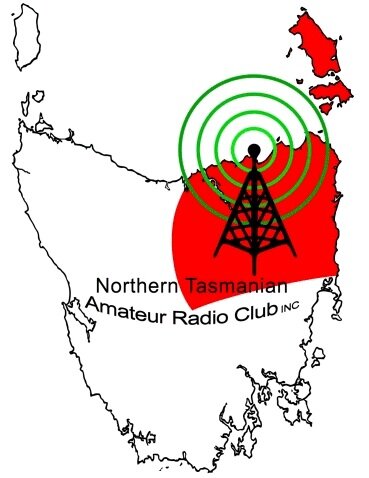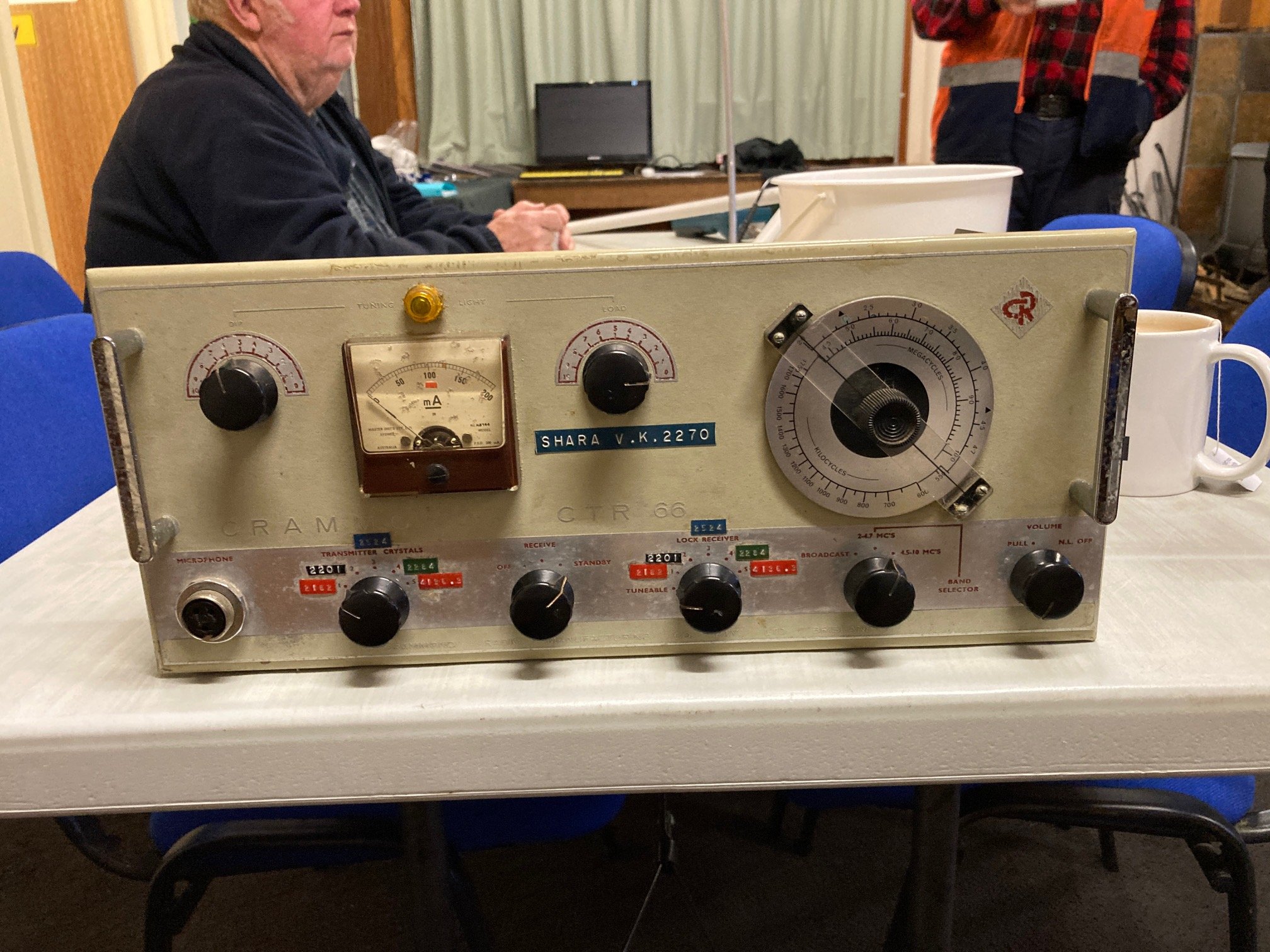Broadcast - 6 Nov 2022
What an excellent turn up for Wednesdays Club Technical night, nice to see a new face fronting up to see what happens on these Nights, good to see you there Nick and hopefully by the end of the evening we hadn’t put you off coming again. New faces are always welcome to drop in and check us out.
Ross VK7ALH, recently acquired an Australian made rig by the Crammond Radio Manufacturing Company in Brisbane. Model number CTR66, it dates back to the late sixties and was primarily intended for Maritime use. So naturally he brought it in!
In 1930 and with the assistance of tariff protection being applied to imported radios, the company started manufacturing receivers on a larger scale and by 1960 had moved into transceivers, mainly supplying the Maritime and Police Department. Luckily this unit was a base station and therefore had minimal corrosion, in fact the under chassis was in excellent condition and really showed off the high standard of manufacturing. It is a valve and transistor hybrid design, incorporating a 50 Watt valve final, and included an inverter to provide valve plate voltages. It incorporated multiband receiver with provision for five plug in crystal pairs when operated in transceiver mode. I still find it incredible just how many communication manufacturing facilities that have disappeared from the Australian landscape over the years!
While we are on the subject of Ross, he has been absolutely incredible over the years for regularly bringing in items that were in various states of aging from his vast stockpile of history. Also, the rigs that were just passing across his work bench that were exhibiting interesting and challenging faults. These have always been a focal point and generated much interest on Club Technical Nights. Surely we must have just about seen everything in his container by now, hihi. Hopefully not, but it is appreciated Ross.
Peter VK7KPC brought in his latest homemade antenna constructional contribution towards his and Phil’s ongoing quest in perfecting their decodes from the NOAA 15, 18 and 19 weather satellite transmissions. It was in the form of a horizontally polarized V-dipole antenna. Peter made up the antenna using a spare centre base or hub from Moonraker UK, this base includes the SO239 socket and balun feeding two right angle arm stubs that were 3/8 x 24tpi thread. Elements were made from aluminium tubing 3/8 outside diameter threaded on one end and 8mm internal thread on the outer element end. 75mm long by 8mm galvanised bolts are inserted into the element and adjusted, i.e. screwed in or out, for best match.
When analysing on his RigExpert 560 the antenna was nearly 50 Ohms with virtually no reactive component. Those movable bolts at the element ends certainly make adjustment easy. From the Discord posted decoded images it appears to be performing admirably on most satellite passes. I have a feeling this is going to be a watch this space ongoing project. Thanks for a look and the progress update Peter.
I know most of us are familiar with AM, Amplitude Modulation and FM, Frequency Modulation but how many have heard of VM, Velocity Modulation?
Well Idris VK7ZIR brought along a mystery item that relies on Velocity Modulation to function. Those of us that have worked in the microwave part of the spectrum recognised it as a Travelling Wave Tube, more commonly known as a TWT. Think of it as a very long and skinny vacuum tube. It is about 300mm long and is 30mm diameter for the first 75mm then about 15mm diameter for the rest of the shaft. It has a standard octal base with a 6.3V heated cathode filament that emits electrons and a collector cap at the distant end of the tube that collects them. It is primarily used to amplify or transmit microwave signals.
Wrapped around the inside of the long tube, just outside the electron beam path, is a helix of copper wire. The RF signal to be amplified is normally fed into the helix via a waveguide or electromagnetic coil placed at the base end. By controlling the accelerating voltage, the speed of the electrons flowing down the tube can be adjusted to be similar to the speed of the RF signal running down the helix. The signal in the wire causes a magnetic field to be induced in the centre of the helix, where the electrons are flowing. Depending on the phase of the signal, the electrons will either be sped up or slowed down as they pass the windings. This causes the electron beam to "bunch up", known technically as "Velocity Modulation". The resulting pattern of electron density in the beam is a copy of the original RF signal. Because the beam is passing the helix as it travels, and that signal varies, it causes induction in the helix, amplifying the original signal. By the time it reaches the other end of the tube, this process has had time to deposit considerable energy back into the helix. Output from the tube is again via waveguide or electromagnetic coil. This particular unit has a typical output of 16Watts in the 3.6 to 4.3 GHz band. The invention of the TWT is often attributed to Rudolf Kompfner in 1942–1943. Apart from microwave communications it was found to be very useful in the development of Radar Systems during World War 2. On July 10, 1962, the first communications satellite, Telstar 1, was launched with a 2 W, 4 GHz TWT transponder used for re-transmitting RF signals back to Earth stations. They have maintained their popularity into this century with dual redundant 12-watt TWTs being mounted on the body under the dish of the New Horizons spacecraft, which visited Pluto in 2015, then Kuiper belt in 2019 and is still sending data to Earth. The humble TWT certainly expanded our horizons, hihi, thank you Idris.
Lionel VK7ZLB, brought in what appeared at first glance to be a hi-tech RF analyser, but in reality was a Galaxy Invader 1000! Yes one of the very first hand held games and it sported a fluorescent display. This pristine little gem was manufactured for Futuretronics of Melbourne. It was an excellent opportunity to re acquaint oneself to the display technology of over forty years ago, it was still sharp with an even blue light output. It is good to see just how well equipment can survive if looked after. However according to the information panel on the back my score of 127 was pathetic! Thanks for the blast of nostalgia Lionel.
The evening’s discussions ranged freely covering a multitude of subjects but funnily enough they always seem to come back to technical matters and by the end of the evening reminiscing about technical matters. Happenings in our life, we take for granted as they happened to us and we know about them, to the rest of us it can be an insight into other technologies, situations and problems. It is quite often enlightening to hear the incredible breadth of technological knowledge and happenings in a group. But that’s half the fun of meeting, “face to face” with a coffee and sausage roll or cake.
At the end of the evening, Bernie VK7BR showed his Domestic Goddess side by vacuuming the carpet ready for Friday coffee morning. Well done Bernie.
An item of interest, Nic VK7WW and Peter VK7KPC have recently taken part in the QRP Hours Contest, this runs from time to time during the year. It is named because of the way it is structured: with one hour dedicated to CW and digital modes, followed by one hour of SSB. The contest varies throughout the year, operating with slightly different conditions, predominantly what bands are permitted, conditions permitting. Once again watch this space to see how our intrepid CW operators went.
Equine Endurance event - The State Championships at Santarena Park, Scottsdale on the 18th & 19th of November is coming up rapidly. This is a request for additional crew members to help us handle this twenty four hour event starting at midnight. Please advise if you are able to assist for any length of time during daylight hours by emailing Roger, VK7ARN or catch up with the Secretary at a Coffee Morning or Tech Session.
UPCOMING EVENTS
TestNet and TechNet – Wednesday 9th November. TestNet/CW course on 3.580MHz from 7pm till 7.30pm….and a TechNet on 3.567MHz from 7.30pm till about 8.30pm. Your host for the evening will be Nic VK7WW.
Club Technical night - Wednesday 16th November. Held at the NTARC Club rooms, 7.30pm until late.
SSTV Net - Held every Thursday night on the 70cm repeater, VK7RJG and linked to the South via repeater VK7RAF. Conducted from about 7.30pm. These SSTV images will be available on the NTARC website
under ‘Blogs’ soon after the event.
Coffee Morning - held every Friday in the NTARC Club rooms. Get warm while you catch up, time is from 10am to noon and we look forward to seeing you all there. We currently have a couple of QSL cards awaiting collection, so why not pop in, check the QSL box and join us for a cuppa and chat.
FINALLY – A reminder to all members that if you have any items of news you would like added to our weekly roundup, no matter how trivial, then please email them to the Secretary at the following address news@ntarc.net all items to be received no later than 5pm on the Friday prior to the Broadcast.
Remember equipment photos and radio propagation maps are available on the NTARC web site under “Blogs” for this week’s broadcast.
That’s all folks,
73 from Stefan, VK7ZSB, Secretary NTARC.









